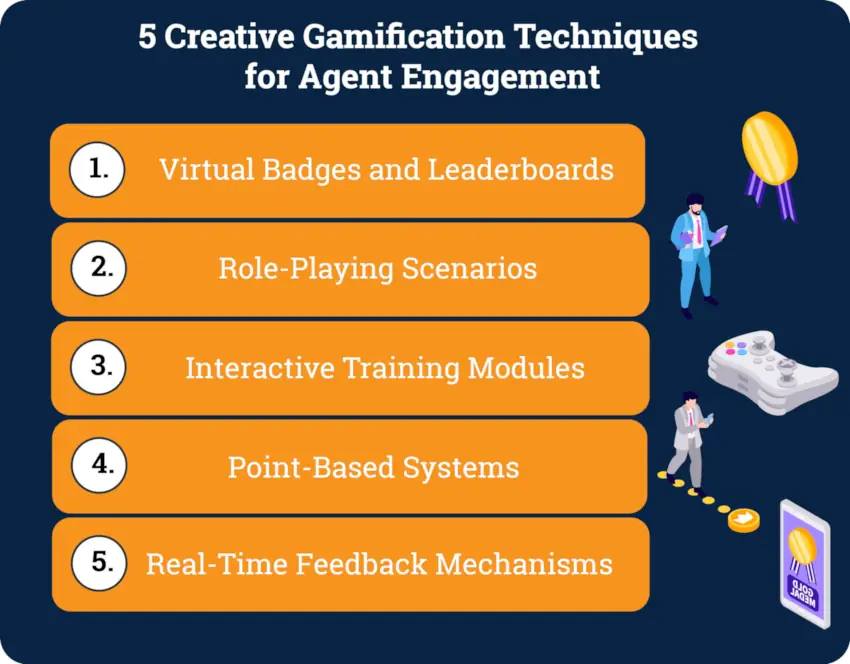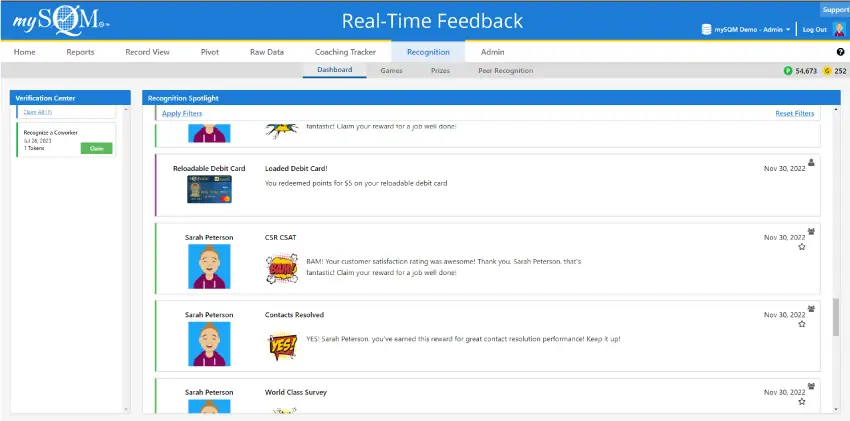High agent engagement leads to increased productivity, enhanced employee satisfaction, and notably lower turnover rates. With remote work as the new normal, traditional motivational strategies might fall short. Enter gamification, a dynamic and innovative approach to boost morale and drive performance. Call centers can transform mundane tasks into exciting challenges by incorporating game-like elements into the workplace.
What Is the Importance of Agent Engagement?
Engaging call center agents is not an option but a necessity for the success of any business that relies on customer service to thrive. The level of commitment and enthusiasm displayed by agents can significantly determine the quality of service delivered, reflecting the company's image and impacting its bottom line. Here are a few impacts of agent engagement:
- Increased Productivity: When fully engaged, agents are more likely to perform at their best, handling customer inquiries efficiently and effectively. This leads to shorter call times, higher FCR rates, and an overall increase in productivity. It's a straightforward equation: higher agent engagement equals better performance outcomes.
- Increased Motivation: The motivation levels among call center agents are directly proportional to their engagement. A motivated agent is eager to contribute, go the extra mile to solve complex issues, and is more likely to stay upbeat through the day's challenges. Motivated agents create a positive work environment that fuels further engagement and motivation across the team.
- Increased Employee Satisfaction: There's a clear link between agent engagement and job satisfaction. Engaged employees feel a sense of belonging and importance within their organization, increasing their job satisfaction. Satisfied employees are less likely to leave, lowering turnover rates and reducing hiring and training costs. Moreover, high employee satisfaction improves team dynamics and a healthier company culture.
What Is Gamification?
Gamification is the application of game-like mechanics in non-game contexts to encourage participation, engagement, and motivation. In a call center setting, this could mean introducing point systems, leaderboards, challenges, and rewards to make everyday tasks more intriguing and rewarding for the agents.
5 Creative Gamification Techniques for Agent Engagement

1. Virtual Badges and Leaderboards
One of the most effective ways to drive agent engagement in call centers is with virtual badges and leaderboards. Virtual badges visually represent an agent's achievements, encouraging healthy competition among team members. For example, agents can earn a virtual badge for receiving positive customer feedback or consistently meeting performance targets.
Conversely, leaderboards rank agents based on their performance metrics, such as call resolution rates or customer satisfaction scores. This visible and transparent competition motivates agents to improve their performance. For example, agents can be ranked based on performance metrics like call resolution rates and customer satisfaction scores.
2. Role-Playing Scenarios
Incorporating role-playing scenarios into the training and development process can significantly boost agent engagement. Agents can practice and hone their problem-solving and communication skills by simulating real-life call center scenarios in a controlled, game-like environment. This method improves their on-the-job performance and makes the learning process more intriguing and enjoyable.
For example, two agents could do role-playing where one agent acts as a customer with issues about a product, and the other agent acts as the call center agent on the other end of the line. A supervisor or more experienced agent could also be present to give feedback and tips on the scenario.
3. Interactive Training Modules
Interactive training modules that employ gamification techniques transform mundane training sessions into dynamic and engaging learning experiences. By integrating quizzes, puzzles, and interactive case studies, these modules make learning more effective. They encourage agents to actively participate and retain information better, thus equipping them with the necessary skills to excel in their roles.
4. Point-Based Systems
Implementing a point-based system is another powerful way to motivate call center agents. Points can be awarded for various achievements, such as meeting daily call quotas, receiving positive customer feedback, or completing training modules.
Accumulated points can then be exchanged for rewards, such as gift cards, extra paid time off, or other incentives. This system instills a sense of accomplishment and directly links performance with tangible rewards, fostering a motivated and engaged workforce.
5. Real-Time Feedback Mechanisms
Real-time feedback mechanisms allow supervisors to provide immediate praise or constructive criticism based on agents' performance. This instant recognition helps agents understand their strengths and areas for improvement in the moment, allowing for rapid adjustment and growth.
For example, mySQM™ QA Software's Real-Time Recognition program awards points based on post-call surveys and QA performance to motivate agents to deliver great CX. Award points are captured in real-time, converted to dollars, and redeemed using an SQM debit card to recognize excellent performance financially.

How to Implement Gamification Strategies
1. Set Clear Objectives
Before rolling out any gamification strategy, setting clear, measurable objectives is crucial. Whether the goal is to decrease average call handling time, improve customer satisfaction scores, or reduce employee turnover, having specific targets ensures that the gamification elements introduced are aligned with the call center's overall business goals.
2. Choose the Right Gamification Platform
Selecting an appropriate gamification platform that fits the specific needs of a call center is essential. The platform should offer a mix of features such as leaderboards, point systems, and real-time feedback tools, all while being user-friendly and capable of integrating with existing call center software. This ensures a seamless implementation and encourages widespread adoption among agents.
3. Train Agents on Gamification Concepts
Finally, training agents on gamification principles and how they apply to their roles is fundamental. This includes explaining the rules of the gamified systems, the reward structure, and how their performance will be measured. Providing this training ensures that all agents understand the objectives and benefits of gamification, leading to greater participation and engagement from the outset.
What Are the Challenges of Implementing Gamification Strategies?
Implementing a gamification strategy is not without its challenges. Recognizing potential obstacles and addressing them head-on is critical for the successful engagement of call center agents through gamification.
- Resistance to change:
Resistance to change is a common hurdle in introducing new strategies, including gamification. Overcoming this requires clear communication about the benefits and objectives of the initiative. Providing training and support can help ease the transition, making agents feel comfortable and valued throughout the process. Celebrating early adopters and sharing success stories can also motivate others to embrace the change more willingly.
- Ensuring inclusivity in gamification strategies:
A successful gamification strategy is inclusive, offering opportunities for all agents to participate and succeed, regardless of their skill levels or backgrounds. Designing challenges and rewards catering to diverse interests and abilities ensures no one is left behind. Regular reassessment of the initiative's inclusivity can help prevent unintended biases and promote a culture of fairness and equality.
- Dealing with remote work challenges:
Remote work presents unique challenges to implementing gamification strategies. Ensuring remote agents feel as involved and motivated as office employees requires creative solutions. Utilizing online platforms and digital tools that facilitate seamless communication and participation is key. Regular virtual meetings and updates can help maintain a sense of community and teamwork among remote agents, keeping them engaged and connected to the organization's goals.
What Are Some Future Trends in Gamification for Call Centers?
As we look forward, several trends stand out, promising to redefine how gamification contributes to productivity, agent motivation, employee satisfaction, and, ultimately, lower turnover rates.
Personalized Gamification Experiences
The one-size-fits-all approach is becoming outdated. In its place, personalized gamification experiences are taking center stage. By leveraging data analytics, call centers can create bespoke challenges and rewards that align with individual agent's preferences, strengths, and areas for improvement. This customization not only boosts engagement but also ensures that each agent feels valued and understood, consequently increasing their loyalty and commitment to the organization.
For example, let's say data analytics reveal that an agent excels in empathy but struggles with technical troubleshooting. A personalized gamification experience for this agent could involve empathy-building exercises paired with targeted training modules on technical skills, with rewards tailored to their preference, such as extra time off for completing the training successfully.
Integration with Artificial Intelligence
AI is set to play a crucial role in streamlining the implementation of gamification in call centers. AI can analyze vast amounts of data in real time, enabling managers to identify trends, predict agent behavior, and tailor gamification strategies accordingly. Furthermore, AI can automate tracking achievements and the distribution of rewards, making the process more efficient and transparent for all involved.
For example, AI algorithms can monitor agent performance metrics in real-time, identifying top performers and areas for improvement. For instance, if an agent consistently exceeds their call resolution targets, AI can automatically award them virtual badges or incentives. This streamlines the gamification process, motivating agents and driving productivity in the call center.
Gamification for Remote Teams
With the new normal of remote work, maintaining agent engagement has become more challenging. Gamification strategies specifically designed for remote teams are emerging as a vital tool. These include virtual leaderboards, online team-building activities, and digital recognition programs. Such strategies ensure that remote agents remain connected to the team's goals and culture, fostering a sense of belonging and community despite the physical distance.
For example, managers can organize online team-building activities, such as virtual scavenger hunts or trivia contests, to encourage collaboration and camaraderie among remote agents.
